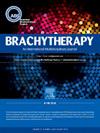Wound complications and local recurrence do not differ when using interstitial brachytherapy versus external beam radiation therapy for soft tissue sarcoma
IF 1.8
4区 医学
Q4 ONCOLOGY
引用次数: 0
Abstract
PURPOSE
Interstitial brachytherapy (BT) is an effective adjuvant treatment alternative to conventional external beam radiation therapy (EBRT) for soft tissue sarcoma (STS). However, little is known about how the wound healing profile of BT compares to that of EBRT.
METHODS
This is a comparative retrospective cohort study including patients receiving interstitial BT or conventional EBRT as adjuvant therapy to STS resection between 2015 and 2022. EBRT patients were included if their excised tumors had flat, planar geometries that would have made them good candidates for either EBRT or BT. Patient demographic parameters, wound closure techniques, wound complications, and oncologic outcomes were analyzed. Statistical analysis comparing wound complications and oncologic outcomes were assessed using chi-square tests.
RESULTS
Thirty-two patients received BT, and 23 similar patients met inclusion criteria who received EBRT. Baseline characteristics did not differ between groups. Twelve BT (37.5%) and 7 (30.4%) EBRT patients experienced some form of wound healing complication (p = 0.587) with necrosis being the most common complication. Seven (21.9%) BT patients and 6 (26.1%) EBRT patients required at least one reoperation to address complications (p = 0.717). Two BT and 1 EBRT patient developed local recurrence, and nine in each group developed metastasis.
CONCLUSIONS
Incidence of wound complications and oncologic outcomes did not statistically differ between BT and EBRT cohorts. In this institutional cohort of appropriately selected STS patients, BT was not inferior to EBRT with respect to wound complication rates and local control.
软组织肉瘤采用间质性近距离放射治疗与外部束放射治疗相比,伤口并发症和局部复发无差异。
目的:间质近距离放射治疗(BT)是替代常规外束放射治疗(EBRT)治疗软组织肉瘤(STS)的有效辅助治疗方法。然而,人们对BT与EBRT相比伤口愈合情况知之甚少。方法:这是一项比较回顾性队列研究,包括2015年至2022年间接受间质性BT或常规EBRT作为STS切除术辅助治疗的患者。如果切除的肿瘤具有平坦的平面几何形状,可以使其成为EBRT或BT的良好候选者,则纳入EBRT患者。分析患者人口统计学参数,伤口闭合技术,伤口并发症和肿瘤预后。采用卡方检验对伤口并发症和肿瘤预后进行统计分析。结果:32例患者接受了BT治疗,23例相似患者符合纳入标准接受了EBRT治疗。各组间基线特征无差异。12例BT患者(37.5%)和7例EBRT患者(30.4%)出现了某种形式的伤口愈合并发症(p = 0.587),坏死是最常见的并发症。7例(21.9%)BT患者和6例(26.1%)EBRT患者需要至少一次再手术来解决并发症(p = 0.717)。2例BT和1例EBRT发生局部复发,两组均有9例发生转移。结论:创伤并发症的发生率和肿瘤预后在BT组和EBRT组之间没有统计学差异。在这个适当选择STS患者的机构队列中,在伤口并发症发生率和局部控制方面,BT并不逊于EBRT。
本文章由计算机程序翻译,如有差异,请以英文原文为准。
求助全文
约1分钟内获得全文
求助全文
来源期刊

Brachytherapy
医学-核医学
CiteScore
3.40
自引率
21.10%
发文量
119
审稿时长
9.1 weeks
期刊介绍:
Brachytherapy is an international and multidisciplinary journal that publishes original peer-reviewed articles and selected reviews on the techniques and clinical applications of interstitial and intracavitary radiation in the management of cancers. Laboratory and experimental research relevant to clinical practice is also included. Related disciplines include medical physics, medical oncology, and radiation oncology and radiology. Brachytherapy publishes technical advances, original articles, reviews, and point/counterpoint on controversial issues. Original articles that address any aspect of brachytherapy are invited. Letters to the Editor-in-Chief are encouraged.
 求助内容:
求助内容: 应助结果提醒方式:
应助结果提醒方式:


